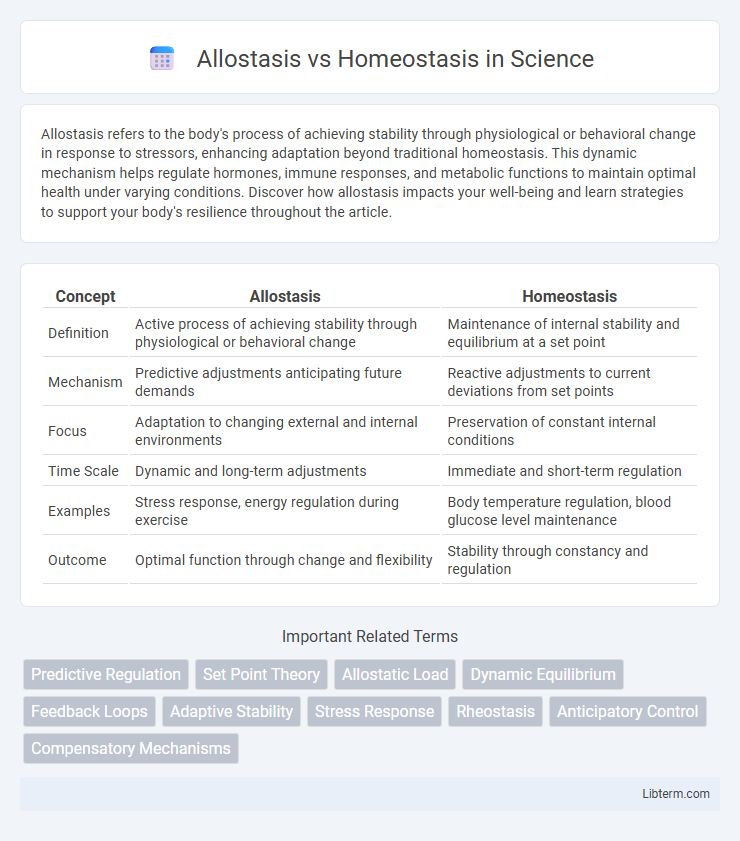Allostasis refers to the body's process of achieving stability through physiological or behavioral change in response to stressors, enhancing adaptation beyond traditional homeostasis. This dynamic mechanism helps regulate hormones, immune responses, and metabolic functions to maintain optimal health under varying conditions. Discover how allostasis impacts your well-being and learn strategies to support your body's resilience throughout the article.
Table of Comparison
| Concept | Allostasis | Homeostasis |
|---|---|---|
| Definition | Active process of achieving stability through physiological or behavioral change | Maintenance of internal stability and equilibrium at a set point |
| Mechanism | Predictive adjustments anticipating future demands | Reactive adjustments to current deviations from set points |
| Focus | Adaptation to changing external and internal environments | Preservation of constant internal conditions |
| Time Scale | Dynamic and long-term adjustments | Immediate and short-term regulation |
| Examples | Stress response, energy regulation during exercise | Body temperature regulation, blood glucose level maintenance |
| Outcome | Optimal function through change and flexibility | Stability through constancy and regulation |
Introduction to Allostasis and Homeostasis
Allostasis refers to the process by which the body achieves stability through physiological or behavioral change, adapting to stressors by altering set points and regulatory systems. Homeostasis involves maintaining internal conditions within narrow, stable ranges despite external fluctuations, relying on feedback mechanisms to regulate variables like temperature, pH, and glucose levels. Both concepts are central to understanding how organisms preserve balance, with allostasis emphasizing dynamic adjustment and homeostasis emphasizing equilibrium maintenance.
Defining Homeostasis: The Body’s Balance
Homeostasis refers to the body's ability to maintain a stable internal environment despite external changes, regulating factors such as temperature, pH, and glucose levels. This dynamic equilibrium relies on feedback mechanisms that detect deviations and initiate physiological responses to restore balance. Understanding homeostasis highlights how organs and systems coordinate to sustain life-supporting conditions essential for health and survival.
Understanding Allostasis: Adaptive Stability
Allostasis refers to the process by which the body achieves stability through physiological or behavioral change, adapting to stressors to maintain optimal function. Unlike homeostasis, which maintains internal constancy by resisting change, allostasis actively adjusts set points and regulatory mechanisms to meet environmental demands. This adaptive stability enables the body to anticipate needs and efficiently respond, promoting resilience and long-term health.
Key Differences Between Allostasis and Homeostasis
Allostasis involves the active process of achieving stability through physiological or behavioral change in response to predicted demands, while homeostasis maintains internal stability by keeping bodily parameters within a fixed range. Allostasis adapts to external and internal stressors dynamically, employing mechanisms like hormonal fluctuations and neural adjustments, whereas homeostasis primarily relies on negative feedback loops to correct deviations from set points. The key difference lies in allostasis's anticipatory regulation versus homeostasis's reactive maintenance of equilibrium.
Mechanisms of Homeostatic Regulation
Homeostatic regulation operates through precise feedback mechanisms involving sensors, control centers, and effectors to maintain internal stability by detecting deviations and triggering corrective responses. Negative feedback loops are fundamental, where changes in physiological parameters such as temperature, pH, or glucose levels are sensed, leading to actions that restore equilibrium. This system enables organisms to sustain consistent internal conditions despite external environmental fluctuations, ensuring optimal cellular function and survival.
Allostatic Processes in Response to Stress
Allostatic processes involve the body's adaptive mechanisms to maintain stability through change by modulating physiological parameters such as cortisol release, heart rate, and blood pressure in response to stress. Unlike homeostasis, which aims to keep internal conditions constant, allostasis dynamically adjusts to external stressors through the activation of the hypothalamic-pituitary-adrenal (HPA) axis and autonomic nervous system. Chronic allostatic load, resulting from repeated or sustained stress responses, can lead to wear and tear on the body, increasing the risk of cardiovascular disease, immune dysfunction, and metabolic disorders.
The Role of the Brain in Allostasis
The brain plays a central role in allostasis by continuously predicting and adjusting physiological responses to maintain stability through change, unlike homeostasis which reacts to deviations from set points. It integrates sensory input, learning, and past experiences to anticipate needs and mobilize resources preemptively, optimizing energy use and enhancing survival. This proactive regulation involves complex neural circuits within the hypothalamus, brainstem, and limbic system, coordinating autonomic, endocrine, and behavioral responses.
Allostatic Load and Its Health Implications
Allostasis refers to the process by which the body achieves stability through physiological or behavioral change, adapting to stressors by altering set points, unlike homeostasis which maintains internal variables within narrow limits. Allostatic load describes the cumulative wear and tear on the body's systems due to chronic overactivation of allostatic responses, contributing to increased risk of cardiovascular disease, metabolic syndrome, and mental health disorders. Elevated allostatic load biomarkers include cortisol dysregulation, hypertension, and inflammatory markers, highlighting its critical role in predicting long-term health outcomes.
Clinical Relevance: Homeostasis vs Allostasis in Disease
Allostasis and homeostasis represent two key mechanisms in physiological regulation, with homeostasis maintaining internal stability through fixed set points, while allostasis adapts to changing environments by anticipating demands. In clinical contexts, failure of homeostasis often leads to acute illnesses such as electrolyte imbalance or hypoglycemia, whereas allostatic overload contributes to chronic conditions like hypertension, diabetes, and heart disease. Understanding the distinction guides therapeutic strategies by addressing either immediate physiological imbalances or long-term adaptive wear and tear on organs and systems.
Future Directions in Allostasis and Homeostasis Research
Future directions in allostasis and homeostasis research emphasize understanding dynamic regulatory processes that maintain physiological balance through adaptive mechanisms. Integrating multi-omics data and advanced computational modeling aims to unravel complex feedback systems and predict responses to chronic stressors. Emerging studies focus on translational applications in precision medicine to improve interventions targeting dysregulated allostatic load and homeostatic imbalance in chronic diseases.
Allostasis Infographic

 libterm.com
libterm.com